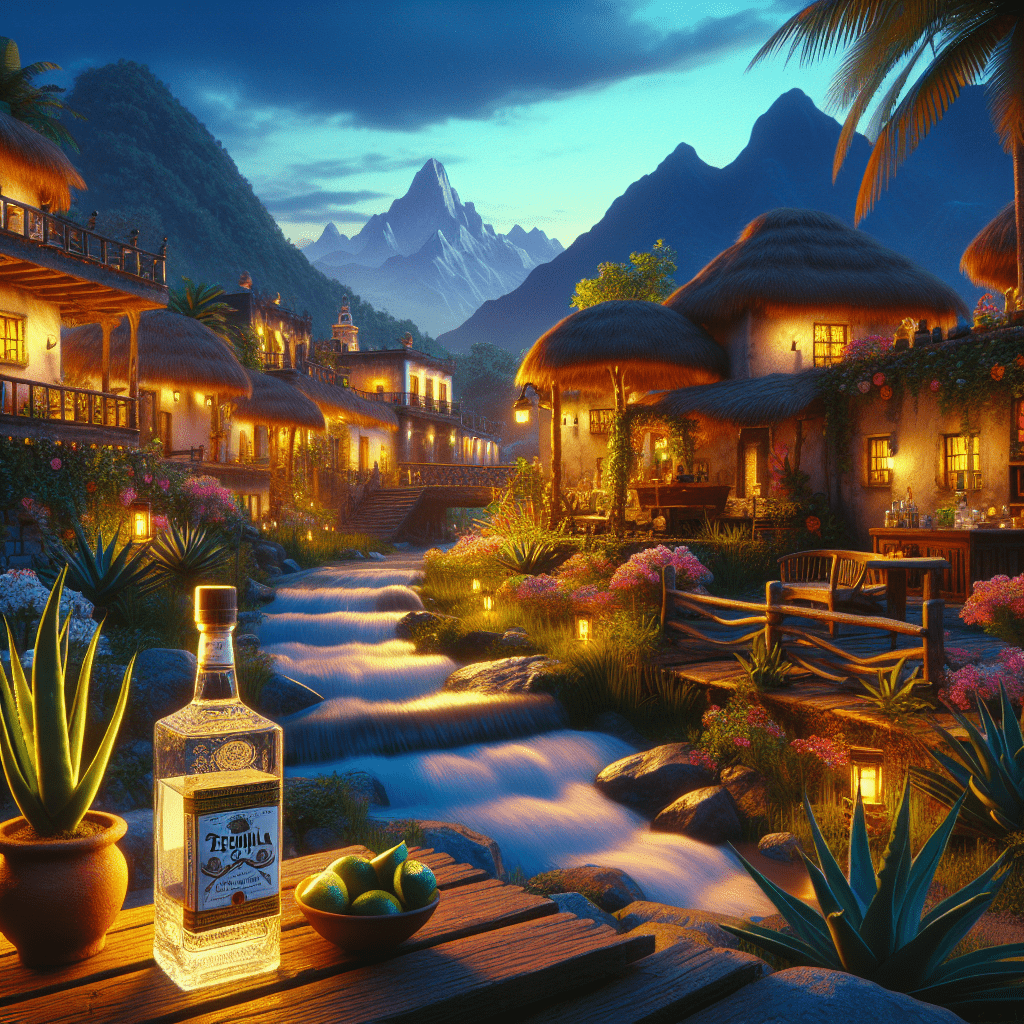-
Table of Contents
Tequila is an iconic spirit deeply rooted in Mexican heritage, embodying the country’s rich history, culture, and tradition. Originating from the state of Jalisco, tequila is made from the blue agave plant and is named after the small town of Tequila. It has been produced in Mexico since the 16th century when Spanish conquistadors began distilling agave to create one of North America’s first indigenous distilled spirits.
The cultural significance of tequila is intertwined with the identity of Mexico, reflecting the country’s agricultural practices, craftsmanship, and social customs. It is a symbol of national pride and is celebrated in art, music, and festivals. The traditional methods of harvesting the agave and the art of tequila making have been passed down through generations, with families dedicating their lives to perfecting this craft.
Tequila’s importance to Mexican culture is also recognized globally. In 2006, UNESCO declared the agave landscape and ancient industrial facilities of Tequila as a World Heritage Site, acknowledging the traditional agricultural landscape and the cultural value of tequila production. This spirit continues to be a cherished part of Mexico’s cultural heritage, enjoyed by people worldwide, and is a testament to the country’s enduring traditions and vibrant history.
Exploring Tequila Heritage: The Roots of Mexican Spirits in Agave Tradition
Tequila’s Mexican Heritage: Understanding the cultural significance
Tequila, the spirited beverage known for its robust flavor and deep cultural roots, is a symbol of Mexican heritage that has transcended borders and become a global phenomenon. This iconic drink is not just a staple at parties and celebrations; it is a testament to the rich history and traditions of the Mexican people. To truly appreciate tequila, one must delve into the heart of its origins, exploring the agave tradition that has been the backbone of this spirit for centuries.
The story of tequila begins with the indigenous peoples of Mexico, who discovered the remarkable properties of the agave plant. Revered for its versatility, the agave was not only used for making beverages but also for food, shelter, and tools. The sap, known as aguamiel, was considered a gift from the gods, and when fermented, it produced a drink called pulque. This ancient beverage laid the groundwork for what would eventually evolve into tequila.
As we journey through time, the Spanish conquest of the 16th century brought with it the process of distillation, which transformed the traditional pulque into a stronger, more refined spirit. The town of Tequila, located in the state of Jalisco, became the epicenter of this evolution. The unique volcanic soil and climate of the region proved to be the perfect environment for growing the blue agave, the only type of agave used in making true tequila.
The production of tequila is steeped in tradition, with methods passed down through generations. The jimadores, skilled laborers who harvest the agave, use a coa, a sharp tool, to expertly cut away the leaves and extract the piña, the heart of the agave. This labor-intensive process has remained largely unchanged over time, showcasing a deep respect for the craft and a commitment to maintaining the authenticity of the spirit.
Once harvested, the piñas are cooked to convert their starches into fermentable sugars, then crushed to extract the sweet agave juice. Fermentation follows, where the magic truly begins as the sugars are transformed into alcohol. Distillation further purifies the liquid, resulting in the clear, potent tequila we know today. Aging in oak barrels can then impart additional flavors and complexity, creating the various types of tequila: blanco, reposado, añejo, and extra añejo.
Tequila’s cultural significance is celebrated annually on National Tequila Day, but its influence extends far beyond this. It is a source of national pride, a reflection of Mexico’s agricultural prowess, and an art form that embodies the spirit of its people. The drink has also played a role in social and economic development, providing livelihoods for countless individuals involved in its production and distribution.
Moreover, tequila has become a cultural ambassador, introducing the world to Mexican customs and traditions. It is often enjoyed in a ritualistic manner, sipped slowly to savor the complex flavors, sometimes accompanied by sangrita, a traditional chaser that complements its taste. The iconic margarita cocktail, which features tequila as its main ingredient, has further popularized the spirit, making it a staple in bars and homes around the globe.
In recognizing tequila’s significance, UNESCO has designated the agave landscape and ancient industrial facilities of Tequila as a World Heritage Site, further cementing its importance as a cultural treasure. This recognition not only honors the history and craftsmanship behind tequila but also ensures the preservation of these traditions for future generations.
In conclusion, tequila is more than just a beverage; it is a vibrant thread woven into the fabric of Mexican culture. Its production is a dance between ancient practices and modern techniques, a balance that honors the past while embracing the future. As we raise our glasses to this storied spirit, we toast to the enduring legacy of Mexico’s agave tradition and the rich heritage that tequila represents. Salud!
The Cultural Significance of Tequila: A Journey Through Mexico’s Distilling History

Tequila’s Mexican Heritage: Understanding the cultural significance
Tequila, the spirited essence of Mexico, is more than just a popular drink; it is a cultural emblem that embodies the rich history, tradition, and identity of the Mexican people. This distilled beverage, made from the blue agave plant, has transcended its origins to become a global phenomenon, yet its soul remains deeply rooted in the heart of Mexico. To truly appreciate tequila, one must embark on a journey through Mexico’s distilling history, exploring the intricate tapestry of its cultural significance.
The story of tequila begins with the indigenous peoples of Mexico, who had been fermenting agave for centuries before the Spanish arrived. The Aztecs, in particular, revered the agave plant, which they called “metl,” and considered it a gift from the gods. They used it to produce a milky, fermented drink called pulque, which played a significant role in their religious and social ceremonies. With the arrival of the Spanish in the 16th century, distillation techniques were introduced, and the native traditions of agave fermentation evolved into the production of what we now know as tequila.
The state of Jalisco, with its rich volcanic soil and ideal climate, became the epicenter of tequila production. The town of Tequila, nestled in the highlands of Jalisco, lent its name to the drink, forever linking its identity to this specific region. The importance of location is so profound that tequila can only be called tequila if it is produced in certain Mexican states, with Jalisco being the most prominent among them. This geographical indication ensures that the spirit’s heritage is preserved and that its connection to the land remains unbroken.
Tequila’s cultural significance is also reflected in the traditional methods of production that have been passed down through generations. The jimadores, skilled laborers who harvest the agave plants, are custodians of an age-old craft. They use a sharp tool called a coa to carefully cut away the leaves and extract the piña, the heart of the agave, which is then cooked, crushed, fermented, and distilled. This labor-intensive process is a testament to the dedication and expertise that goes into every bottle of tequila.
Moreover, tequila is deeply intertwined with Mexican festivities and social gatherings. It is a symbol of celebration, often enjoyed during national holidays such as Cinco de Mayo and Dia de los Muertos. The ritual of sipping tequila, accompanied by a bite of lime and a pinch of salt, is a communal experience that fosters a sense of unity and shared heritage. Tequila also plays a pivotal role in the mariachi culture, with its lively music and vibrant performances that are synonymous with Mexican joy and pride.
In recent years, tequila has gained international acclaim, with connoisseurs around the world appreciating its complexity and versatility. Premium tequilas, aged in oak barrels, have elevated the spirit to a level of sophistication that rivals the finest whiskies and cognacs. Yet, even as tequila enjoys its global renaissance, the heart of its cultural significance remains in Mexico, where each sip tells a story of the land, the people, and the traditions that have shaped it.
In conclusion, tequila is not just a drink; it is a cultural artifact, a distilled expression of Mexico’s history and spirit. From the ancient rituals of the Aztecs to the global recognition it enjoys today, tequila’s journey is a testament to the enduring legacy of Mexican culture. As we raise our glasses to this remarkable spirit, we celebrate not only its unique flavor but also the rich tapestry of heritage that it represents.
Agave Tradition and Tequila: Unveiling the Mexican Heritage of Distilled Spirits
Tequila’s Mexican Heritage: Understanding the cultural significance
Tequila, the spirited essence of Mexico, is more than just a popular drink; it is a symbol of national pride and cultural heritage. This distilled spirit, derived from the blue agave plant, carries with it centuries of tradition, history, and social significance. To truly appreciate tequila, one must delve into the agave tradition and unveil the rich tapestry of Mexican heritage that has shaped this iconic beverage.
The story of tequila begins with the indigenous peoples of Mexico, who discovered the potential of the agave plant long before the Spanish conquest. The agave, a hardy succulent native to the arid regions of Mexico, was revered for its versatility. It provided food, fiber, and, most importantly, the fermented drink pulque, which was consumed during religious ceremonies and social gatherings. The cultural importance of agave is deeply rooted in the pre-Hispanic era, setting the stage for the evolution of tequila.
With the arrival of Spanish conquistadors in the 16th century, the distillation process was introduced to the New World. The indigenous practice of fermenting agave was combined with this new technique, giving birth to what would eventually become tequila. Initially, tequila was a rustic, local spirit, but over time, it gained popularity and began to spread beyond the borders of its birthplace.
The town of Tequila, nestled in the state of Jalisco, is the heartland of tequila production. It is here that the blue agave fields stretch as far as the eye can see, painting the landscape with a unique beauty that has become synonymous with Mexican identity. The importance of this region is so profound that in 2006, the agave landscape and ancient industrial facilities of Tequila were declared a UNESCO World Heritage Site, cementing its place in the cultural fabric of the nation.
Tequila’s production is steeped in tradition, with methods passed down through generations. The jimadores, skilled laborers who harvest agave, use a coa, a sharp, hoe-like tool, to expertly trim the leaves and extract the piña, the heart of the agave. This labor-intensive process has remained largely unchanged for centuries, a testament to the enduring legacy of Mexican craftsmanship.
The distillation process itself is a blend of art and science, with master distillers overseeing the transformation of the agave’s sugars into alcohol. The resulting spirit is then aged in oak barrels, where it develops its distinct flavors and aromas. From the clear, unaged blanco to the rich, complex añejo, each type of tequila tells a story of its own, inviting connoisseurs and casual drinkers alike to explore its depths.
Tequila’s cultural significance extends beyond its production. It is a staple of Mexican celebrations, from national holidays like Cinco de Mayo and Dia de los Muertos to personal milestones such as weddings and birthdays. It is a symbol of hospitality and friendship, often shared among guests to create a sense of camaraderie and joy.
Moreover, tequila has become an ambassador for Mexican culture on the global stage. As its popularity soars internationally, it carries with it the values, traditions, and spirit of the Mexican people. It is not merely an export but a cultural emissary, inviting the world to partake in the rich heritage of Mexico.
In conclusion, tequila is more than just a beverage; it is a cultural artifact, a liquid narrative of Mexico’s history, traditions, and values. The agave tradition is a thread that weaves through the fabric of Mexican society, binding the past with the present. As we raise our glasses to toast, we are not just enjoying a drink; we are partaking in a legacy that has been distilled through the ages, a true embodiment of Mexico’s vibrant spirit.
Q&A
1. What is the origin of tequila and its cultural significance in Mexico?
Tequila originated in the 16th century in the area surrounding the city of Tequila, which is located in the highlands of the western Mexican state of Jalisco. It is culturally significant as a symbol of Mexican identity and heritage, representing the fusion of pre-Hispanic traditions and Spanish distillation techniques. The drink is made from the blue agave plant, which has deep roots in Mesoamerican societies where agave was considered a gift from the gods and used for various purposes, including religious rituals and medicine.
2. How is tequila traditionally produced and what does this process represent for Mexican culture?
Traditional tequila production involves harvesting the mature blue agave plants, cooking the piñas (the heart of the agave) to convert starches into sugars, fermenting the extracted juice, and then distilling it into tequila. This process is labor-intensive and has been passed down through generations, representing the dedication to craftsmanship and the importance of maintaining cultural practices. The production is closely tied to the region’s economy and way of life, with many families and communities involved in the tequila industry for centuries.
3. What role does tequila play in Mexican celebrations and social life?
Tequila plays a central role in Mexican celebrations and social life, often consumed during national holidays, weddings, birthdays, and other festivities. It is a drink that brings people together, symbolizing hospitality and friendship. Tequila is also used in traditional toasts (brindis) to honor individuals or commemorate special occasions. Its presence in these events underscores its importance as a cultural emblem and a celebratory beverage deeply ingrained in Mexican social customs.Tequila is deeply rooted in Mexican heritage, symbolizing the country’s history, culture, and traditions. Originating from the state of Jalisco, tequila is made from the blue agave plant and is protected by a denomination of origin, meaning it can only be produced in certain regions of Mexico. This spirit has become an emblem of national identity, celebrated in art, music, and festivals. Its production involves traditional methods passed down through generations, reflecting the fusion of pre-Hispanic and Spanish influences. Tequila’s cultural significance extends beyond its role as a beverage, representing the resilience and pride of the Mexican people, and contributing to the country’s economy and global image.






